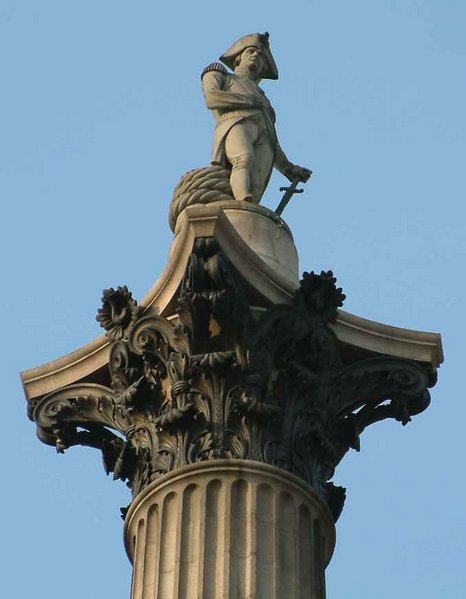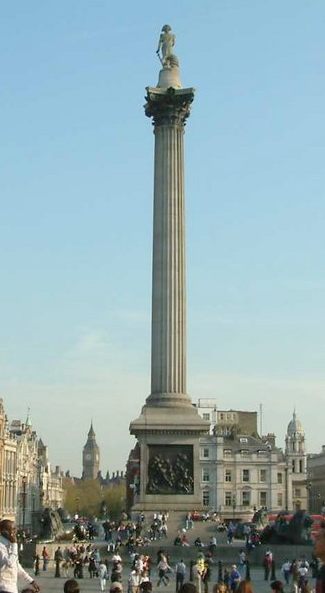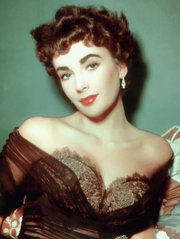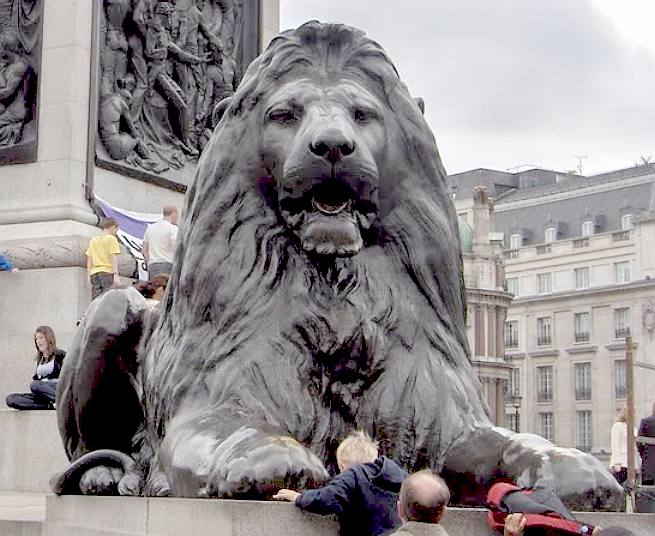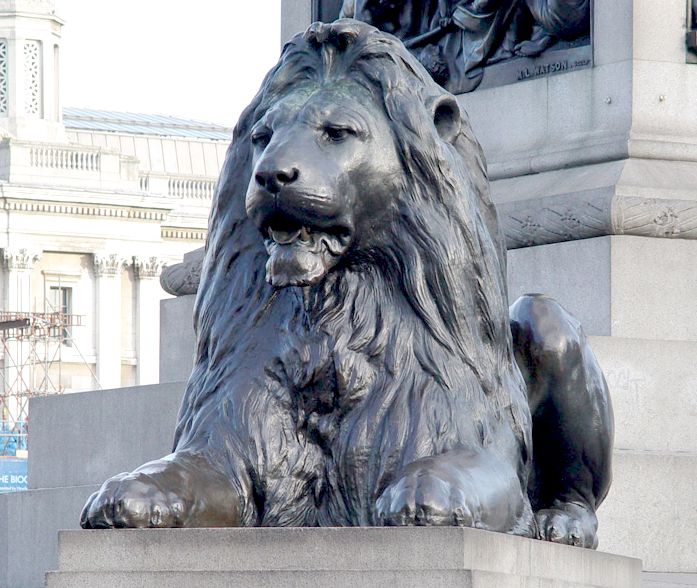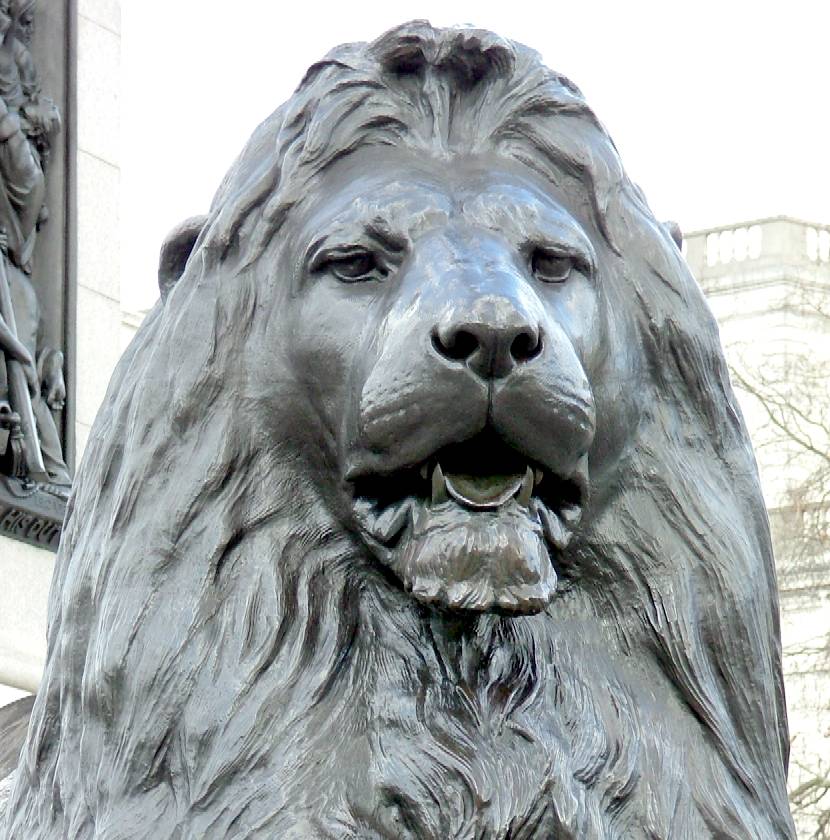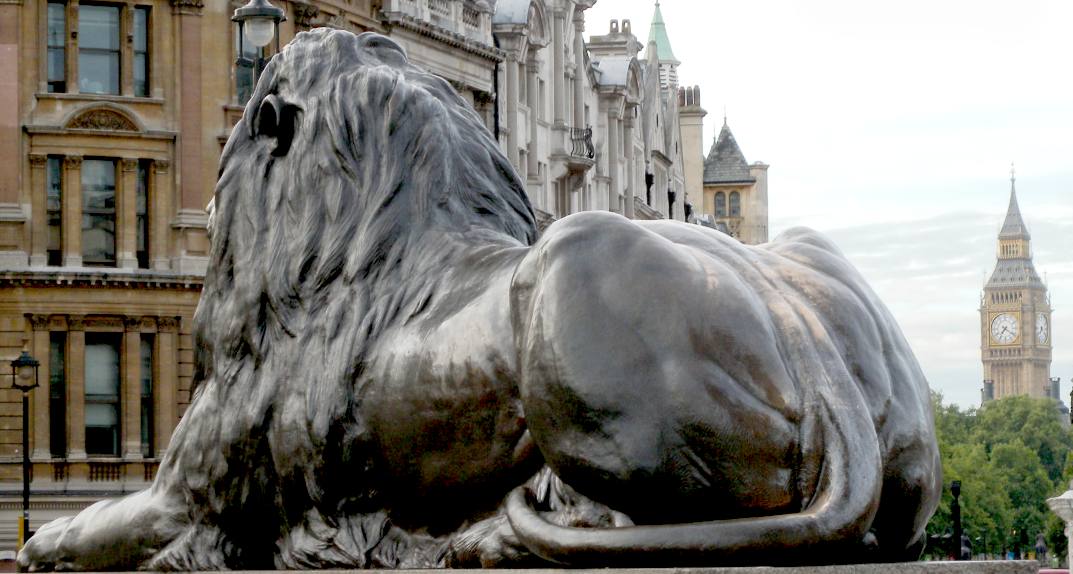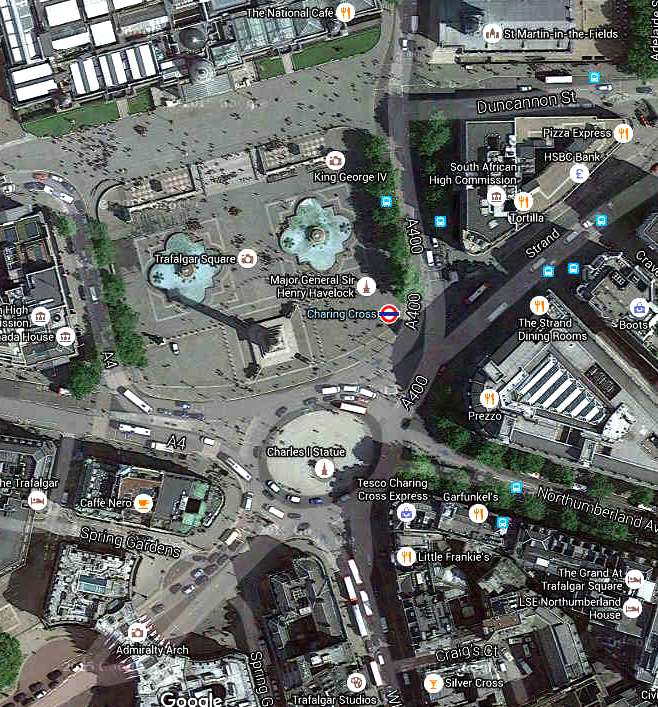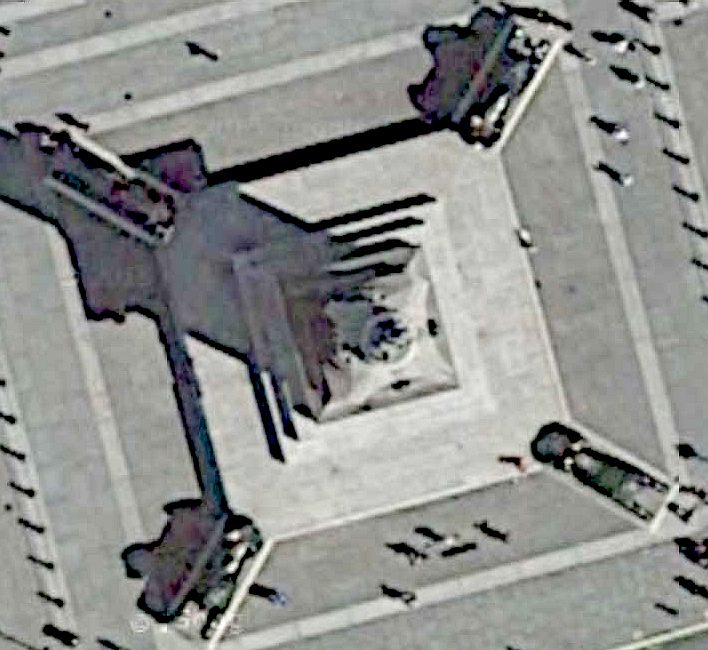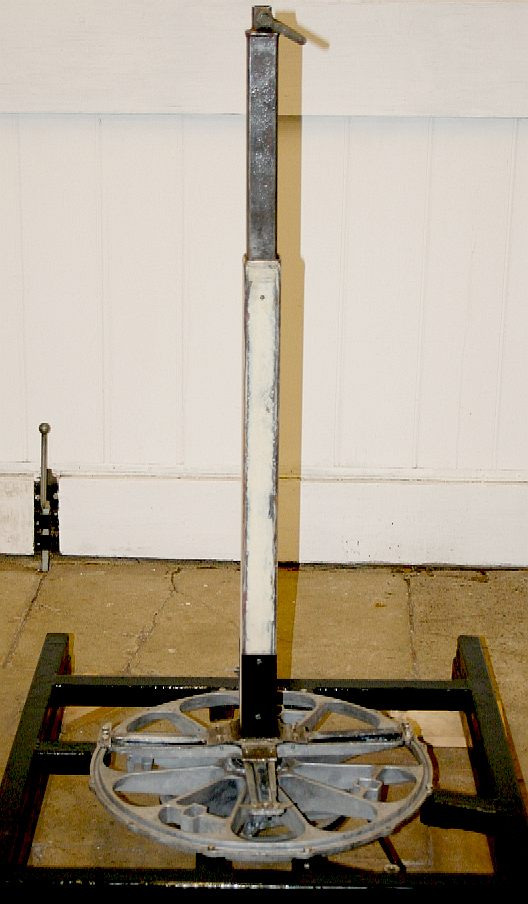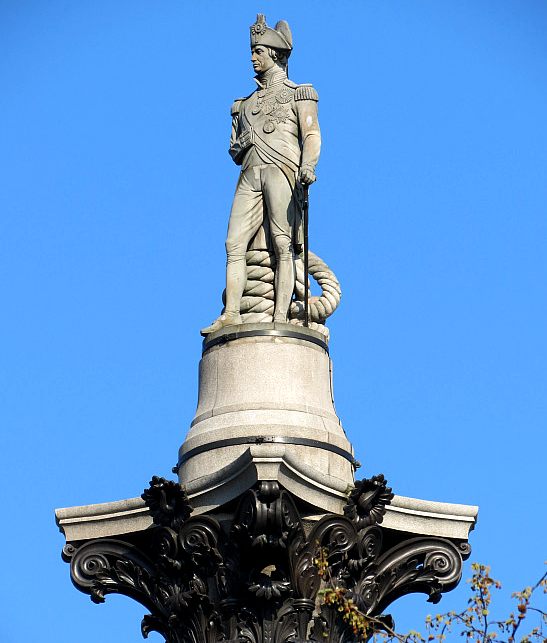|
NELSON'S COLUMN - TRAFALGAR SQUARE, LONDON ENGLAND
HOME | BIOLOGY | GEOGRAPHY | HISTORY | INDEX | MONEY | SPORT
|
||||
|
Nelson's Column is a monument in the centre of Trafalgar Square in London. It was built between 1840 and 1843 to commemorate Admiral Horatio Nelson, who died at the Battle of Trafalgar in 1805. It consists of a 5.5m (18ft) statue of Nelson on top of a 56 m granite column. The statue faces south, towards the Palace of Westminster.
The top of the Corinthian column is decorated with bronze acanthus leaves cast from British cannon. The square pedestal is decorated with four bronze panels, cast from captured French guns, depicting Nelson's four great victories.
The monument was designed by architect William Railton in 1838. His original 1:22-scale stone model is exhibited at the National Maritime Museum in Greenwich.
Horatio Nelson, 1st Viscount Nelson, KB 1758-1805
Trafalgar Square is a square in central London that commemorates the Battle of Trafalgar (1805), a British naval victory of the Napoleonic Wars. The original name was to have been "King William the Fourth's Square", but George Ledwell Taylor suggested the name "Trafalgar Square".
The area had been the site of the King's Mews since the time of Edward I. In the 1820s the Prince Regent engaged the landscape architect John Nash to redevelop the area. Nash cleared the square as part of his Charing Cross Improvement Scheme. The present architecture of the square is due to Sir Charles Barry and was completed in 1845. General
The square consists of a large central area surrounded by roadways on three sides, and stairs leading to the National Gallery on the other. The roads which cross the square form part of the busy A4 road, and prior to 2003, the square was surrounded by a one-way traffic system on all sides. Underpasses attached to Charing Cross underground station still allow pedestrians to avoid traffic. Recent works have reduced the width of the roads and closed the northern side of the square from traffic.
Nelson's Column Trafalgar Square
Nelson's Column is in the centre of the square, surrounded by fountains and four huge bronze lions sculpted by Sir Edwin Landseer; the metal used is said to have been recycled from the cannon of the French fleet. The column is topped by a statue of Lord Nelson, the admiral who commanded the British Fleet at Trafalgar.
On the north side of the square is the National Gallery and to its east the St Martin's-in-the-Fields church. The square adjoins The Mall via Admiralty Arch to the southwest. To the south is Whitehall, to the east The Strand and South Africa House, to the north Charing Cross Road and on the west side is Canada House.
At the corners of the square are four plinths; the two northern ones were intended to be used for equestrian statues, and thus are wider than the two southern. Three of them hold statues: George IV (northeast, 1840s), Henry Havelock (southeast, 1861, by William Behnes), and Sir Charles James Napier (southwest, 1855). Mayor of London Ken Livingstone controversially expressed a desire to see these replaced with statues of people more relevant to the 21st century. More statues of modern heroes in newer places perhaps, but let's keep our heritage intact.
In 1888 the statue of General Charles George Gordon was erected. In 1943 the statue was removed and re-sited on the Victoria Embankment in 1953.
The Square has become an enormously important symbolic social and political location for visitors and Londoners alike, developing over its history from "an esplanade peopled with figures of national heroes, into the country’s foremost place politique," as historian Rodney Mace has written. Its symbolic importance was demonstrated in 1940 when the Nazi S.S. developed secret plans to transfer the Nelson Column to Berlin following an expected German invasion, as related by Norman Longmate in If Britain Had Fallen (1972).
Nelson's Column Trafalgar Square, London, England
PIGEONS
The square is a popular tourist spot in London, and used to be particularly famous for its pigeons (rock doves). Feeding the pigeons was a popular activity with Londoners and tourists. The National Portrait Gallery displays a 1948 photograph of Elizabeth Taylor posing there with bird seed so as to be mobbed by birds. The desirability of the birds' presence has long been contentious: their droppings look ugly on buildings and damage the stonework, and the flock, estimated at its peak to be 35,000, was considered to be a health hazard. In 1996, police arrested one man who was estimated to have trapped 1500 birds for sale to a middleman; it is assumed that the birds ended up in the human food chain.
In 2000 the sale of bird seed in the square was controversially terminated and other measures were introduced to discourage the pigeons, including the use of trained falcons. Supporters of the pigeons and some tourists continued to feed the birds, but in 2003 Ken Livingstone enacted by-laws to ban the feeding of pigeons within the square. There are now relatively few birds in Trafalgar Square, and it is used for festivals and hired out to film companies, in a way that was not feasible in the 1990s.
In 1858 the government commissioned Landseer to make four bronze lions for the base of Nelson's Column in Trafalgar Square, following the rejection of a set in stone by Thomas Milnes. Landseer accepted on condition that he would not have to start work for another nine months, and there was a further delay when he asked to be supplied with copies of casts of a real lion he knew were in the possession of the academy at Turin. The request proved complex, and the casts did not arrive until the summer of 1860. The lions were made at the Kensington studio of Carlo Marochetti, who also cast them. Work was slowed by Landseer's ill health, and his fractious relationship with Marochetti. The sculptures were installed in 1867.
Trafalgar Square is located at the intersection of The Strand and Northumberland Avenue, lovely for Monopoly players. The National Gallery and Admiralty Arch are sights worth seeing in this location. Use Google maps or other similar services to plan your journey. Does this not remind you of the Arc de Triomphe de l'Étoile, Triumphal Arch of the Star, one of the most famous monuments in Paris. It stands in the centre of the Place Charles de Gaulle (originally named Place de l'Étoile), at the western end of the Champs-Élysées.
This is as close up as Google maps gets using their satellite setting. In other regions the definition is better, as with the street function.
TRIBUTE - This show stand that was made for the Innovate 2015 exhibition in London, November 9-10, bears a striking resemblance to Nelson's Column in that the base has a cross-tree very much like that of the famous statue. There is though a marked difference in scale, with the stand above measuring only 5 feet in height. Also, the stand above rotates with an electric motor and has LED in the base for a light display. Both the motor and LEDs had not been invented in Nelson's day. All this needs (apart from painting) to complete the look, is four lions on each of the base pedestal radians, or in each corner facing outward - as per the layout at Trafalgar Square seen above.
External links
Detailed overview of sculpture at Trafalgar Square The Guardian: Mayor attacks generals in battle of Trafalgar Square BBC on "Alison Lapper Pregnant" The Death of Nelson' (1806) by Benjamin West 'Life onboard HMS Victory: an educational resource Tapping the Admiral from World Wide Words. The Death of Lord Nelson, 1807, by William Beatty from Project Gutenberg
The Battle of Trafalgar
GENERAL HISTORY LINKS
MARITIME HISTORY
Nelson's Column is a monument in Trafalgar Square in central London built to commemorate Admiral Horatio Nelson, who died at the Battle of Trafalgar in 1805. The monument was constructed between 1840 and 1843 to a design by William Railton at a cost of £47,000. It is a column of the Corinthian order built from Dartmoor granite. The Craigleith sandstone statue of Nelson is by E. H. Baily and the four bronze lions on the base, added in 1867, were designed by Sir Edwin Landseer.
|
||||
|
This website is Copyright © 1999 & 2015 Max Energy Limited, an environmental educational charity working hard for world peace. The names SeaVax™, Blueplanet Ecostar BE3™ and Miss Ocean™ are trademarks. All other trademarks are hereby acknowledged.
|

